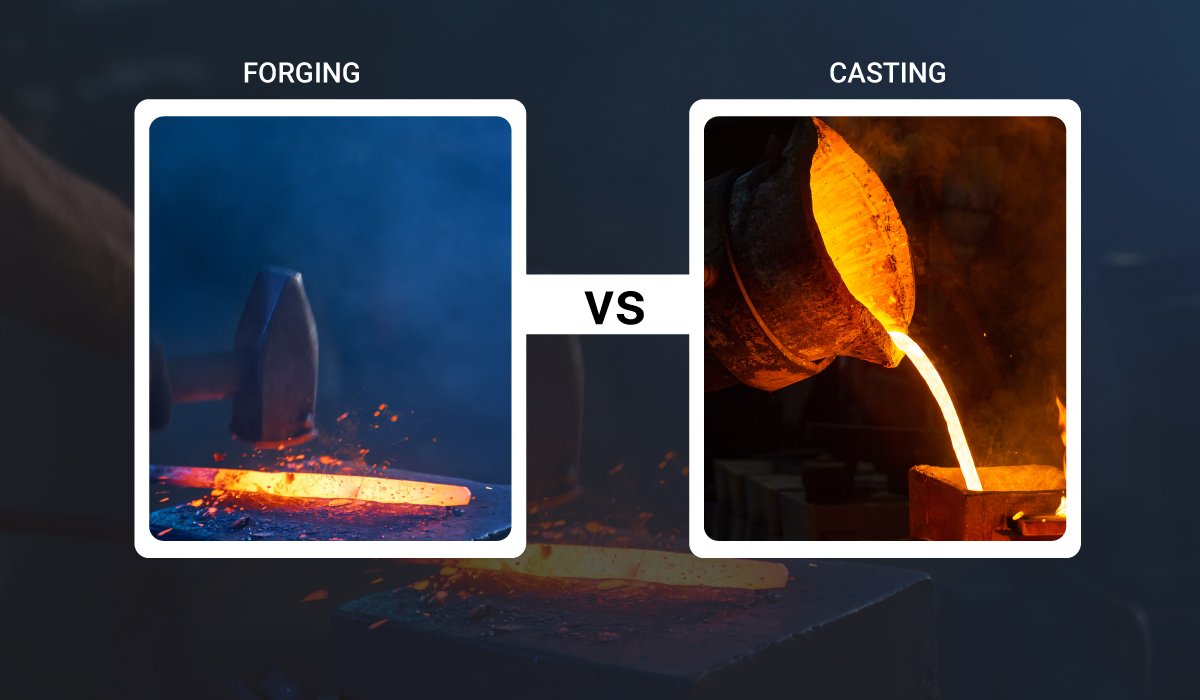When it comes to manufacturing metal parts and components, there are two popular techniques that are widely used: casting and forging. Although both methods involve shaping metal into the desired form, they are fundamentally different processes with distinct advantages and disadvantages.
In casting, molten metal is poured into a mold and allowed to cool and solidify into the desired shape. This technique is commonly used to produce complex shapes that are difficult or impossible to achieve with other methods. On the other hand, forging involves applying pressure and heat to a piece of metal to shape it into the desired form. This method is known for producing strong, durable parts that are often used in high-stress applications.
In this blog post, we will explore the key differences between casting and forging, as well as their respective advantages and disadvantages. We will also discuss some common applications for each technique and provide insights into which method might be best suited for your specific manufacturing needs.
Definition of Casting
A liquid or molten material, usually metal or plastic, is poured into a mold during casting and allowed to harden into the desired shape. The material used for casting is usually heated until it becomes a liquid or molten state, which is then poured into a mold that has been created to the desired shape of the final product. Once the material has been poured into the mold, it is left to cool and solidify, after which the mold is removed, leaving behind the solidified casting. The casting may require further processing, such as trimming or polishing, to achieve the final desired shape and finish. Casting is commonly used to create complex shapes or parts that would be difficult or impossible to manufacture through other processes. It is used in a wide range of industries, including automotive, aerospace, and construction. Different types of casting methods include sand casting, investment casting, die casting, and continuous casting.
What is Forging?
Forging is a manufacturing process in which a solid piece of metal is shaped into a desired form by applying localized compressive forces. The process typically involves heating the metal to a specific temperature, which makes it easier to shape, and then using a hammer, press, or other forging tool to apply force to the metal and shape it into the desired form. Forging can be used to create parts with high strength, durability, and resistance to fatigue and impact. This makes it a popular method for producing components used in high-stress applications, such as aircraft and automotive parts, industrial machinery, and construction equipment. There are several different types of forging methods, including open-die forging, closed-die forging, and roll forging. Each method has its own unique advantages and disadvantages, and the choice of method depends on factors such as the size and complexity of the part, the desired properties of the final product, and the quantity of parts needed.
What is the Difference Between Casting & Forging?
Casting and forging are two different manufacturing processes used to shape metal. The casting process involves pouring molten metal into a mold and allowing it to solidify into the desired shape, while forging involves using compressive forces to shape a solid piece of metal. In casting, the molten metal is poured into a mold, which can be made of various materials such as metal, sand, or ceramic. The mold is then removed once the metal has solidified, and any finishing work is done on the casting. This process is ideal for creating complex shapes and intricate designs, but the final product may have some surface defects and may not be as strong as a forged part.
In forging, a solid piece of metal is heated to a specific temperature and then shaped using compressive forces, such as hammering or pressing. This process produces strong, durable parts with excellent mechanical properties, making them ideal for high-stress applications. Forged parts also have a higher level of structural integrity and are less likely to have surface defects. Overall, the main difference between casting and forging is the starting material and the method used to shape it. Casting uses molten metal and a mold, while forging uses a solid piece of metal and compressive forces to shape it. The choice of process will depend on the specific application and the desired properties of the final product.
Casting and Forging Process in brief
Casting and forging are two widely used manufacturing processes that involve shaping metal into desired forms.
- The casting process involves pouring molten metal into a mold and allowing it to solidify into the desired shape. There are various types of casting methods, such as sand casting, investment casting, die casting, and continuous casting, depending on the type of material and the complexity of the part being produced. Casting is suitable for creating complex shapes and intricate designs that may not be achievable with other processes. However, the final product may have surface defects and may not be as strong as a forged part.
- Forging, on the other hand, involves heating a solid piece of metal and shaping it using compressive forces such as hammering or pressing. There are several types of forging methods, including open-die forging, closed-die forging, and roll forging, depending on the size and complexity of the part. Forging produces strong and durable parts with excellent mechanical properties, making them ideal for high-stress applications.
In summary, casting and forging are two different processes used to shape metal into desired forms. The choice of process will depend on the type of material, the complexity of the part, and the desired properties of the final product.
Conclusion
At Microcare, we offer a range of cleaning solutions that are specially designed for the casting and forging industries. Our products can help to remove contaminants and impurities from metal parts during the manufacturing process, ensuring that the final product is of the highest quality. Whether you are casting or forging parts for aerospace, automotive, or industrial applications, our team of experts can help you find the right cleaning solution for your needs. By partnering with Microcare, you can be confident that you are using the most effective cleaning solutions available, and that your parts will meet the highest standards of quality and performance.


